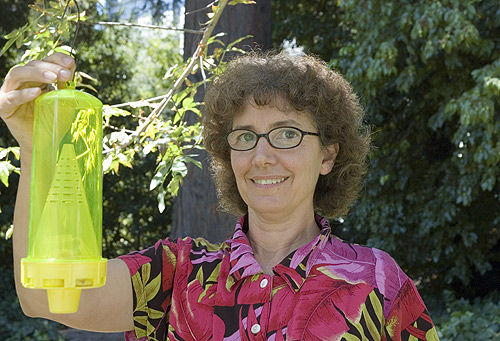Berkeleyan
 Margaret Hurlbert displays the yellowjacket trap that is an essential tool of her trade. (Wendy Edelstein photo) |
It's My Job
22 August 2007
 |
In this new semi-regular feature, the Berkeleyan showcases a staff member whose work is essential to the smooth functioning of the campus (or one of its many departments and units). Do you know someone whose job would interest our readers? Send an e-mail to berkeleyan@berkeley.edu with your suggestions.
Margaret Hurlbert
Lead, Pest Management, Physical Plant - Campus Services
Do you have a typical day?
Each day is different. Usually there are a variety of calls - about anything from yellowjackets to giant cockroaches. I get calls about common pests like ants and mice, and unusual ones like a bat in a building, a skunk in a manhole, or a praying mantis in a library.
What's a common misperception people have about your job?
People often think of pest control as someone running around with a big spray can. But we developed one of the first integrated-pest-management programs in the country.
What does that mean?
We use a variety of techniques - sanitation, habitat modification, prevention, pest exclusion, and education. We think of the overall picture, and focus on prevention as much as eradication, if not more.
What methods do you use?
We trap yellowjackets around dining facilities, childcare centers, children's sports camps, and the stadium. We educate people about keeping food sealed and throwing organic waste into outside trashcans to prevent mice and other pests. We place metal strips along the base of exterior doors as a way to exclude rodents from buildings.
What other kinds of pests do you manage?
We rescue injured animals, and remove birds and bats from buildings. We also have a feral-cat management program in which we trap, fix, and release feral cats, and find homes for their kittens. We use one-way doors to exclude raccoons, skunks, and opossums from under buildings.
Tell us about a major success you've had.
Brown-banded cockroaches were a terrible problem in research labs on campus in the 1970s and '80s. At the time, there were no baits commercially available that would kill them. When we noticed that cockroaches disappeared from a building that had parasitic wasps nesting inside, we thought that might be the answer to our problem. We've been rearing and releasing wasp eggs inside campus research buildings for 30 years now, with excellent results.
What's an ongoing challenge?
We encounter people who are fearful of pests, and we need to stay calm and reassure them that we will solve their problem.
Though it seems like your work is crucial, it's invisible.
Not being noticed is actually a good thing in this field. Pest control, after all, isn't noticed unless it doesn't get done!

